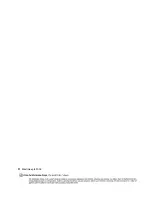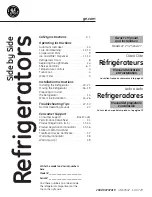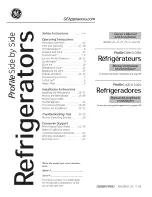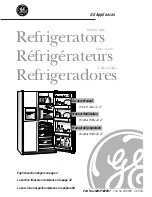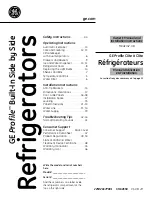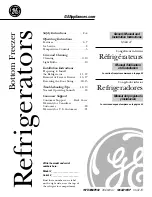
7
Normal Operating Sounds
•
You may hear faint gurgling or bubbling sounds
when the refrigerant is pumped through the coils
or tubing at the rear, to the cooling
plate/evaporator.
•
When the compressor is on, the refrigerant is
being pumped round, and you will hear a whirring
sound or pulsating noise from the compressor.
•
A thermostat controls the compressor, and you
will hear a faint ’click’ when the thermostat cuts in
and out.
Food Storage
To obtain the best performance from your fridge-
freezer
•
Do not store warm food or evaporating liquids.
•
Avoid buying frozen food if you cannot store it
straight away. The use of an insulated container is
advisable. When you arrive home place the frozen
food in the freezer immediately.
•
Keep the time between buying chilled food and
placing it in your refrigerator as short as possible.
•
Do not push food together too much, try to allow
air to circulate around each item.
•
Do not store food uncovered.
•
Ensure that food placed in the freezer is dated
and labelled and used in date order to ensure
that food is consumed at its best.
•
Remove suspect food from your refrigerator and
clean, refer to Maintenance and Cleaning.
•
Lean food keeps better and longer than fatty food,
salt reduces the storage time.
•
Wrap the food in polythene or aluminium freezing
bags or foil so that they adhere to the food and
provide an airtight seal .
•
Packaging which is swollen or has traces of
refrozen water droplets on the pack could indicate
that the product has not been kept at a suitable
temperature and that it may have lost its original
quality. Partially thawed food must not be
refrozen, it must be consumed within 24 hours.
Never exceed the storage times indicated by the
manufacturer.
Energy Saving Advice
•
Do not install the appliance close to sources of
heat, such as a boiler or radiator.
•
Locate the appliance in a cool well ventilated
room and make sure that the air openings of the
appliance are not obstructed.
•
Avoid unnecessary frosting in the cabinet by
packing all foodstuffs into airtight packages
before placing them in the freezer.
•
Always leave warm food to cool down to room
temperature before placing in the fridge.
•
Food which is to be frozen (when cool) should be
placed in the fridge before being transferred to
the freezer.
•
Thaw frozen food in the fridge. This will ensure
safer defrosting of foods and reduce the work of
the refrigeration unit.
•
Try to avoid keeping the door open for long
periods or opening the door too frequently as
warm air will enter the cabinet and cause the
compressor to switch on unnecessarily often.
•
Ensure there are no obstructions preventing the
door from closing properly.
In the Event of a Power Failure
If there is a power failure during the storage of frozen
foods, keep the door closed. If the temperature within
your freezer should rise, do not refreeze the food
without checking its condition. The following
guidelines should assist you:
Ice-cream:
Once thawed should be discarded.
Fruits & Vegetables:
If soft should be cooked and
used up.
Breads & Cakes:
Can be refrozen without danger.
Shellfish:
Should be refrigerated and used up
quickly.
Cooked Dishes:
i. e. casseroles should be
refrigerated and used up.
Large Pieces of Meat:
Can be refrozen providing
there are still ice crystals remaining within them.
Small Joints:
Should be cooked and can then be
refrozen as cooked dishes.
Chicken:
Should also be cooked and refrozen as a
fresh dish.
HINTS AND TIPS
14
INSTALLATION
Positioning
This appliance should only be installed at a location
where the ambient temperature corresponds to the
climate classification indicated on the rating plate,
which is located at the left on the inside of the
appliance.
The following table shows which ambient
temperature is correct for each climate classification:
SN +10°C to + 32°C
N +16°C to + 32°C
ST +18°C to + 38°C
T +18°C to + 43°C
It should be located in a dry atmosphere, out of
direct sunlight and away from extreme temperature
e.g. not next to a boiler or radiator, or in a very cold
room e.g. an outhouse, where the temperatures may
fall below 10°C (50°F). If these temperatures are
exceeded i.e. colder or warmer, then the appliance
may not operate correctly.
You should also ensure that air can circulate freely
around the back and the top of the cabinet. There
must also be at least 100 mm (4”) distance between
the top of the cabinet and any overhanging kitchen
furniture (A). Ideally, the appliance should not be
positioned beneath overhanging furniture (B).
There should also be a gap of 25 mm either side of
the appliance. Do not obstruct the space
underneath. The back of the cabinet may be placed
close to the wall but must not touch it. DO NOT
install in places with restricted ventilation.
Adjust the level of the appliance by screwing out the
adjustable foot, or feet, at the bottom of the cabinet
using your fingers or a tool (see figure).
D200
A
B
NP005
100 mm
10 mm
10 mm
Warning
IF YOU ARE DISCARDING AN OLD APPLIANCE
THAT HAS A LOCK OR CATCH ON THE DOOR,
YOU MUST ENSURE THAT IT IS MADE
UNUSABLE TO PREVENT YOUNG CHILDREN
BEING TRAPPED INSIDE.
Rear spacers
The plastic bag containing all relevant
documentation also contains two spacers to be fitted
into special holes in the back of the appliance.
Fit the spacers into the holes, taking care to ensure
that the arrow (A) is positioned as shown in the
diagram. Then turn them through 45° (arrow (A)
vertical) until they lock into place.
PR60
A
45°
Important
It must be possible to disconnect the appliance from
the mains power supply; the plug must therefore be
easily accessible after installation.
Depending upon the position which you choose for
your appliance, you may wish to reverse the way in
which the door opens. To do this, refer to instructions
on “Door reversal directions” paragraph.
Содержание ZETF 180 W
Страница 1: ...REFRIGERATOR FREEZER ZETF 180 W ZETF 180 SI INSTRUCTION BOOKLET 2222 251 33...
Страница 17: ......
Страница 18: ......
Страница 19: ......
Страница 20: ...Electrolux plc 2003...




















